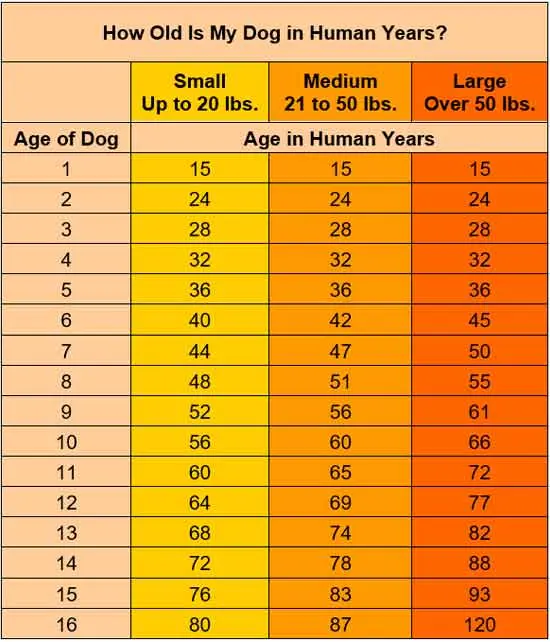Dog Age Chart: Forget the 7 Years to 1 Myth
Dogs age astonishingly fast in the first year of life, and from there splits off into size and breed differentials. But you can influence the outcomes more than you think, with these five longevity tricks. Check this chart for your dog's human age today, then proactively enhance his life span.

STORY AT-A-GLANCE
- It’s important for pet parents to be aware that dogs age very rapidly compared to humans; in fact, your dog at just 1 year of age is the equivalent of you at 15
- Since your dog’s life will be short, it’s important to try to ensure he spends every day healthy and happy
- Tips for raising a vibrant, long-lived dog include offering the right diet, keeping her lean and well-conditioned, and refusing all unnecessary vaccines
- It’s also important to perform at-home wellness checkups, arrange for routine veterinary care and regularly enrich your dog’s environment
Editor's Note: This article is a reprint. It was originally published December 19, 2018.
Pet parents, especially those with older dogs, often don't realize (or perhaps just don't want to think about) how quickly furry family members age compared to us. Many are surprised to learn their "still acts like a puppy" pet is technically a senior or geriatric dog. There's a general guideline many veterinarians use to convert a dog's age to human years. The following chart is provided by the American Kennel Club (AKC):1

As you can see from the chart, dogs of all sizes do a lot of growing and maturing during their first year. It takes the average human 15 years to reach the same level of maturity. In their second year, dogs zip through another 9 years in human time, and then the aging process slows down a bit at year 3.
Until the age of 5, dogs of all sizes age at about the same pace, but in year 6, medium and especially large breeds start to outpace smaller dogs. By age 10, large dogs are approximately 10 years older in human years than small dogs. By age 12, the gap between them is 13 years.
Because dogs have such abbreviated lives compared to ours, it's incredibly important that we do everything possible to make their time with us healthy and happy.
5 Tips to Help Your Dog Have a Long, Healthy Life
- Feed a nutritionally balanced, species-appropriate diet — When it comes to helping your pet have a long, healthy life, there is no single thing more important than providing him with the right nutrition. To be optimally healthy, dogs need high-quality animal protein and fats, and a small amount of vegetables and fruits that provide antioxidants and fiber to animals that no longer hunt whole prey.
Your dog needs unadulterated, fresh, whole foods that are moisture-dense. He doesn't need grains, fillers, artificial preservatives, colors, additives, chemicals, byproducts or processed or genetically modified (GM) foods. Although dogs can eat some processed foods, they aren't designed to consume a lifetime of dry or canned diets.
To gauge the nutritional quality of the diet you're currently feeding your pet, see this updated list of best-to-worst pet foods. You can also use this list for guidance on how to improve your dog's diet. - Keep your dog at a healthy weight — Overweight and obese pets are such a widespread problem that many dog owners don't even realize their canine companion is too heavy to be healthy. Feeding too much of the wrong kind of food is how the problem usually starts. As a carnivore, the foundation of your dog's diet should be animal muscle meats, organs and bones, and a moderate amount of fat.
Unfortunately, the foundation of most popular, affordable commercial pet diets is grains, carbohydrates and fillers, which are exactly the ingredients carnivores are not designed to eat. Biologically inappropriate nutrition can contribute not only to obesity, but to a long list of diet-related diseases as well.
Lack of adequate exercise is also a big risk factor in creating a too-heavy dog. Our pets are designed to be physically active for optimal health. Not only does insufficient exercise help pack on the pounds, but it can also cause extreme boredom and lack of mental stimulation, which can result in a whole host of behavior-related issues. - Refuse needless vaccinations — "Needless" vaccinations for most dogs who received well-timed puppy shots include:
- Yearly boosters of the core vaccines (distemper, parvo, adenovirus for dogs; panleukopenia, calici, herpes for cats)
- Any noncore vaccines your pet doesn't absolutely need
Over-vaccinating can create serious short- and long-term health problems for your cat or dog. Yes, many pets enjoy long lives despite yearly re-vaccinations, but many others have developed vaccine-associated sarcomas, autoimmune disorders and other life-threatening diseases.
Puppies and dogs should be administered a first round of core vaccines (distemper, parvo and adenovirus — no parainfluenza) before 12 weeks of age, usually around 9 to 10 weeks. Then, the second round is given between 15 and 16 weeks. Two weeks after the second round, I titer to ensure the dog has been immunized and not just vaccinated.
When it comes to rabies, the first vaccine should be given at 6 months, and then as required by law, a booster one year later and every three years thereafter. In lieu of automatic re-vaccinations for the other cores, antibody titer tests at three-year intervals are recommended to ensure your pet remains immune to the diseases she has been vaccinated against.
Check here for a detailed discussion of the latest veterinary canine vaccine guidelines, how to determine if your dog needs non-core vaccines and the benefit of titer tests versus automatic re-vaccination. - Perform at-home exams and schedule regular wellness visits with your veterinarian — Our dogs can't tell us when they hurt or feel sick. That's why it's so important for pet parents to perform routine do-it-yourself at-home checkups. It's a great way to detect changes in your dog's health as soon as they occur so that you can take immediate action. It's also a great bonding opportunity for you and your pet.
Often dogs aren't seen by a veterinarian until an illness is in an advanced stage. This usually means the animal has been suffering for some time, and sadly, it can mean there's no way to stop or reverse the progress of the disease. Not every condition can be detected by a physical exam, of course, but you'd be surprised how many potential health crises are averted by an alert pet owner who detects a problem and makes an appointment with their veterinarian.
A healthy pet should get veterinary wellness exams twice yearly. Older pets and those with chronic conditions may need to be seen more often. If two visits a year isn't feasible for you, it's crucial to at least go for an annual wellness visit to your vet.
It’s also ideal to have a integrative or holistic practitioner on your pet's health care team. There is a lot that can be done to improve the health and quality of life of your animal companion beyond what traditional Western medicine offers. - Regularly enrich your dog's environment — Environmental enrichment means enhancing your pet's surroundings and lifestyle so that he is presented with novelty in his environment, opportunities to learn and encouragement to engage in instinctive, species-specific behaviors. Ways to do this can include:
- Providing a supply of different types of toys in varying shapes, sizes, textures, colors and scents
- Ensuring he receives adequate daily exercise/playtime
- Taking him on different types of walks
- Providing him with regular opportunities for social enrichment, for example, visits to the dog park, play dates with other dogs or involvement in activities such as agility and nose work
If there's room for improvement in your dog's lifestyle, it's never too late to think about what you can do differently to help your four-legged family member enjoy better health and longevity.











